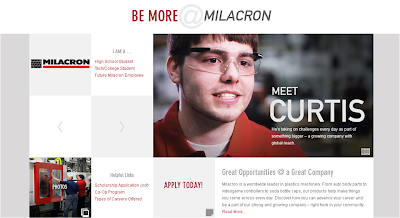
The statistics are in, and they’re good. After only six days live, Milacron’s new recruitment website has had 883 unique visitors, more than 4,011 page views and 260 people who filled out forms requesting employment opportunities.
Like many manufacturers, Milacron, a worldwide leader in plastics machinery, was experiencing a workforce shortage and needed help in attracting talent. The initial success of their new microsite is both a testament to the ability of a well-designed website to attract prospective employees and to the fact that there are people looking for manufacturing jobs.
In November, we wrote about 5 ways that manufacturers can address their workforce shortage. We have since been working with Milacron and other clients to put these ideas in actions.
Here are 5 key takeaways from the Milacron Talent Acquisition campaign:
1. Integrate the program: The initial launch of the microsite would not have been as successful had it not been surrounded by a strategic, multi-faceted program. The campaign encompasses social media presence including Facebook and Twitter, as well as public relations securing both local and trade publication coverage. The company is also fostering relationships with local technical and vocational schools, offering both a co-op program and a scholarship program and promoting Milacron as a good choice for job shadowing, apprenticeship and eventually permanent employment.
2. Base the execution in research: Before designing and executing the campaign, interviews were conducted with current employees at Milacron to understand what was important to the young people in the organization – what they valued about working at Milacron. These interviews were coupled with background research into Millennials to better understand what this generation responds to and cares about. The research informed the employment brand and position as well as the development of the microsite and the surrounding marketing program.
3. Include video: Video is a medium increasingly preferred to receive online information and is especially important for reaching younger people. We conducted onsite video and photo shoots featuring young people inside the organization. These videos will continue to be used throughout recruitment efforts.
4. Create an employment brand: Leveraging the research, we developed an employment brand centered on showing prospective employees how they can “Be More at Milacron.” The messaging is woven throughout the microsite and video testimonials and will continue to serve as a foundation to speak to current and prospective employees, students, parents, educators and the marketplace.
5. Build an appealing careers section: The careers sections of many manufacturers’ websites leave a lot to be desired. The section needs to be informative and engaging, helping to familiarize students, teachers, parents and other non-industry individuals with a basic understanding of manufacturing in a way that highlights the long-term, technologically advanced and personally fulfilling career benefits the field can offer. A good careers section should be user friendly with intuitive navigation and be visually appealing to audiences, especially young people.



 SAVE TO DEL.ICIO.US
SAVE TO DEL.ICIO.US